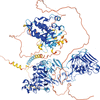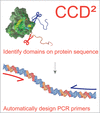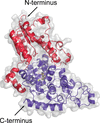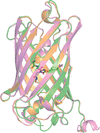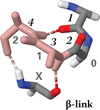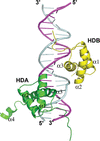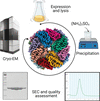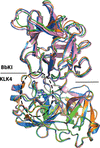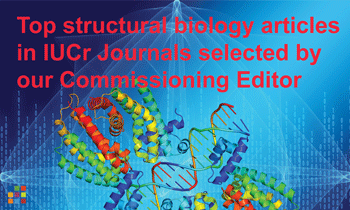issue contents
August 2021 issue

Cover illustration: AlphaFold2 prediction of the full-length chain of human EGFR color coded by model confidence (dark blue, highly confident; dark orange, very low confidence) [Bouatta et al. (2021), Acta Cryst. D77, 982–911]. Individual domains are confidently predicted, but inter-domain arrangement is not, as evidenced by long unstructured linkers with very low model confidence.
feature articles
Open  access
access
 access
accessThis review discusses the AlphaFold2 system for protein structure prediction, including its conceptual and methodological advances, its amenability to interpretation and its achievements in the last Critical Assessment of protein Structure Prediction (CASP14) experiment.
CCP4
Open  access
access
 access
accessCCD2 is a software tool that aggregates sequence information for protein sequences (conservation, structure prediction, domain and disorder detection), enabling informed choices for expression-construct design, the single-click generation of PCR primers for cloning and easy data tracking.
research papers
Open  access
access
 access
accessA crystal structure of a photolyase at room temperature confirms the structural information obtained from cryogenic crystallography and paves the way for time-resolved studies of the photolyase at an X-ray free-electron laser.
This work explores the structural and spectrophotometric implications of replacing a tyrosine residue in the chromophore of a fluorescent protein with two different unnatural amino acids.
Open  access
access
 access
accessThe crystal structure of the lytic polysaccharide monooxygenase McAA9F, which is broadly active on both crystalline and soluble glycans and includes an unusual succinimide motif, is reported.
PDB reference: McAA9F, 7ntl
Open  access
access
 access
accessCrystal structures are presented of the full-length VanR protein in both the inactive and activated states. Activation involves a disorder-to-order transition in a critical helix, which creates an interface for dimerization.
Open  access
access
 access
accessThe β-link, which is a motif consisting of a G1β β-bulge and a type II β-turn, is shown to play the specific role in protein architecture of connecting a β-sheet to another area of a protein in certain β-sandwiches, small β-barrels and β-sheet/α-helix proteins.
Open  access
access
 access
accessThe STENOFOLIA homeodomain binds promoter DNA as a tetramer and the α3 helix binds DNA in both the major and minor grooves.
PDB reference: STENOFOLIA homeodomain, 6wig
Structures of α-glucosidase from Weissella cibaria BBK-1 (WcAG) in complex with various ligands, including a maltosyl N-linked enzyme intermediate, are reported. This work reveals a restricted active site of WcAG for short-chain maltooligosaccharides.
PDB references: α-glucosidase from Weisella cibaria BBK-1, wild type, 7d9b; E374Q mutant, complex with maltose, 7d9c; E374Q mutant, complex with maltotriose, 7dcg; E374Q mutant, complex with acarbose, 7dch; D345N mutant, complex with maltose, 7ehh; D345N mutant, covalent maltosyl-α-glucosidase intermediate, 7ehi
Open  access
access
 access
accessA simple expression and purification protocol is presented which produces a high yield and good micrographs of the apoferritin bacterioferritin B (BfrB) from Mycobacterium tuberculosis. Its 2.12 Å resolution cryo-EM structure is presented, revealing a unique C-terminal extension (164–181), and it is discussed how BfrB could serve the growing cryo-EM community in characterizing and pushing the limits of their electron microscopes and workflows.
EMDB reference: bacterioferritin B, EMD-12738
PDB reference: bacterioferritin B, 7o6e
The crystal structures of complexes of human kallikrein 4 with BbKI, an inhibitor from Bauhinia bauhinioides, and of four of its reactive-site variants were determined in several crystal forms and were compared with the structures of complexes of Kunitz-type inhibitors with other serine proteases.
PDB references: BbKI, complex with human kallikrein 4, 7jod; 7joe; 7jos; 7jow; R64A mutant, complex with human kallikrein 4, 7jqk; R64M mutant, complex with human kallikrein 4, 7jqn; R64D mutant, complex with human kallikrein 4, 7jqo; R64F mutant, complex with human kallikrein 4, 7jqv; R64F mutant, complex with trypsin, 7jrl; R64M mutant, complex with trypsin, 7jr2; R64F mutant, complex with chymotrypsin, 7jrx
Open  access
access
 access
accessEnsemble refinement of six protein–ligand crystal structures indicates a much larger flexibility of some amino-acid side chains and ligand groups than is suggested by standard crystallographic refinement. Molecular-dynamics simulations and automatic generation of alternative conformations confirm the high flexibility of these groups, indicating that ensemble refinement can be used to identify such flexible groups.


 journal menu
journal menu









